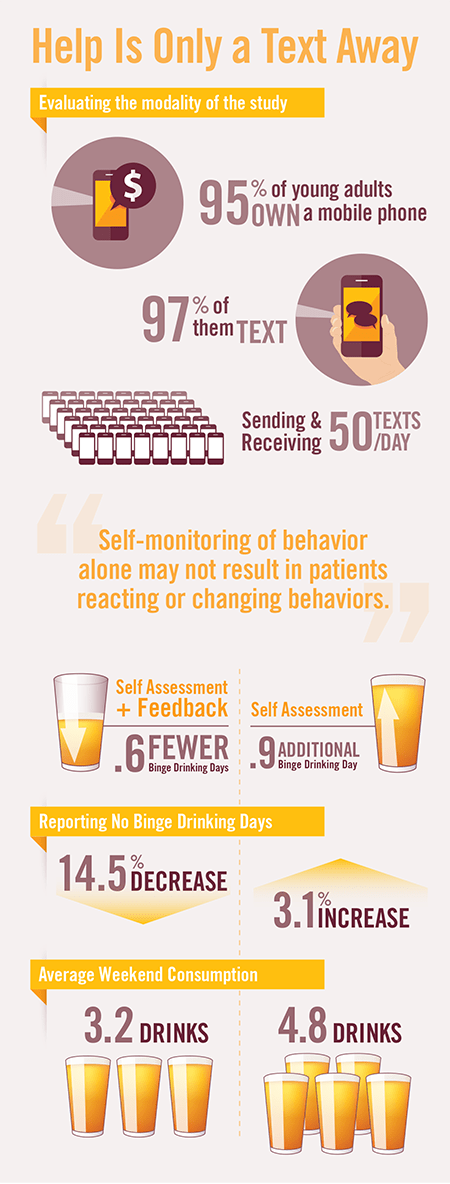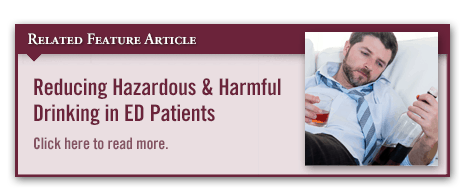Each year, more than 50,000 adults between the ages of 18 and 24 visit EDs, and about half have hazardous alcohol use patterns. “Alcohol is a leading preventable cause of mortality for young adults,” says Brian Suffoletto, MD, MS. The ED provides a unique setting to screen young adults for drinking problems because emergency physicians may be able to engage them in participating in interventions to reduce future use. The key, however, is to determine patients’ preferred mode of communication.
Text messaging is a promising modality that could help clinicians effectively deliver brief interventions for alcohol use, especially among younger adults. Dr. Suffoletto says it is important to offer clinicians an alternative to lengthy in-person interviews and counseling with patients because these options are often not possible in the short time that is available during clinical encounters. About 95% of young adults own a mobile phone, and 97% of them use short message service (SMS), either sending or receiving an average of 50 texts per day. In previous research, SMS has been used to help with many young adult health issues, including diabetes, asthma, and cigarette smoking. However, few analyses have explored the effect of an SMS intervention to reduce alcohol use among young adults.
Dr. Suffoletto says that in some respects, a mobile program that interacts with people over time in their natural environment makes more sense when supporting behavior change. “A text message-based intervention can reach young adults in an environment where they’re making drinking choices,” he says. “This allows us to connect with patients when the issue can be addressed before these problematic behaviors begin.” It is also possible that SMS-delivered alcohol interventions can reduce the need for training providers to deliver alcohol interventions and reach large numbers of people in a cost-efficient manner.
Testing an Intervention
In a study published in Annals of Emergency Medicine, Dr. Suffoletto and colleagues evaluated the efficacy of a 12-week SMS intervention that was designed specifically for younger adults. The intervention encouraged lowering alcohol consumption, specifically binge drinking, which was defined as five or more drinks per occasion for men and four or more drinks per occasion for women. The study group enrolled 765 young adult emergency patients who had a history of hazardous drinking.
For 12 weeks, one-third of the participants received SMS assessments (SA) that prompted them to respond to drinking-related queries plus feedback. This group also received text messages in return that offered feedback on their answers (SA+F). The feedback was tailored to strengthen patients’ low-risk drinking plan or goal or to encourage them to reflect on their drinking plans or their decisions not to set a low-risk goal. One-third of the participants received SA but without feedback, and the remaining participants (the control group) received no text messages.
A Combined Approach Works
Patients randomized to the SA+F group had a 51% decrease in the number of self-reported binge drinking days from baseline to 3 months, but increases were observed in the SA and control groups (Table 1). There were also decreases in the number of self-reported drinks per drinking day in the SA+F group, but increases were seen for the other two groups. About 31% of SA+F participants reported weekend binge drinking during 12 weeks, compared with a 48% rate for SA participants. There was also a lower average of drinks consumed per weekend in the SA+F group when compared with the SA group (3.2 vs 4.8 drinks, respectively).
Fewer patients in the SA+F group reported any binge drinking in the last 30 days from baseline to 3 months when compared with the SA and control groups (Table 2). Dr. Suffoletto says that patient self-awareness of being a hazardous drinker and being asked to report alcohol use at baseline did not appear to reduce alcohol use. “Self-monitoring of behavior alone may not result in patients reacting or changing behaviors,” he says. “We need to find ways to intervene in a meaningful way in the health and habits of these patients when they’re young. Doing so may enable us to make real progress in reducing the burden of hazardous alcohol use and to help patients avoid becoming repeat ED visitors.”
Aiming for Improvements
Dr. Suffoletto says that the effect sizes of the text-message intervention were relatively small, but he notes that even modest reductions among a large number of drinkers could lead to greater gains when compared with more expensive efforts to address the problem. “We recognize that our SMS intervention may not be optimized,” he says. “Future text-message interventions may need to incorporate additional components to keep younger adults engaged at higher rates. We also need to look at incorporating other behavioral techniques that have been useful for alcohol prevention.”





 TimH
TimH